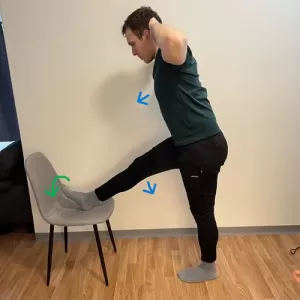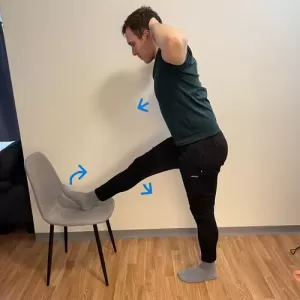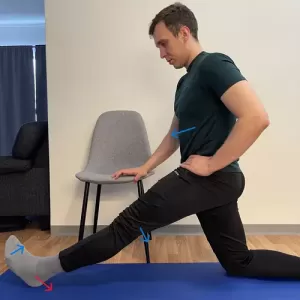How to Increase Hamstring Flexibility (Ultimate Guide)
In this guide, I’ll show you the most effective techniques for increasing hamstring flexibility.
I’ll show you how to stretch your hamstring muscles, factors that influence hamstring flexibility, how to leverage them and much more.
Let’s dive in.
Step 1: Warmup and Dynamic Stretching
The easiest way to increase hamstring flexibility is with proper warm-up.
All muscles, including the hamstring, become more flexible after they’re warmed.
A proper warm-up includes light aerobic activity and dynamic stretches.
Here is a five-minute warm-up routine for hamstrings I like:
- Jumping Jacks 3x30s
- Front Leg Swings 3×20
- “Touch your toes” 3×10
Jumping jacks exercise will increase your HR and prepare your whole body for physical activity, while front leg swings and touch your toes exercise stretch your hamstring muscles.
Step 2: Static Stretching for Hamstrings
Static stretches, where you hold a position for a period, are crucial for deeply stretching the hamstring muscles and improving their flexibility.
In this part I want to show you how to perform static stretches for different hamstring muscles.
That way you will ensure proper hamstring flexibility in all hamstring muscles.
How to stretch the outer part of hamstrings (Biceps Femoris)
- Start by standing upright with one foot placed on a chair.
- Rotate your leg slightly inward, keeping your knee slightly bent.
- Place your hands behind your head.
- Gently push your upper body forward and hold for 30s.
*With internally rotating your leg you target more the outer part of hamstrings – the biceps femoris muscle.
How to stretch the inner part of hamstrings (Semimembranosus)
- Stand with one foot on a raised surface, such as a step or a chair.
- Keep the leg slightly bent and lean forward, reaching for the toes.
- Push down gently with your knee.
- Hold the stretch for 30 seconds and repeat on the other leg.
Step 3: PNF Stretching for Hamstrings
Proprioceptive Neuromuscular Facilitation (PNF) stretching involves contracting and relaxing the hamstring muscles, which leads to an increase in hamstring flexibility.
One of the most effective PNF methods is Hold-Relax stretching technique (HR).
This technique involves stretching the hamstrings for a few seconds, then contracting them for five to ten seconds, followed by a relaxed stretch for ten to fifteen seconds.
See the example bellow.
- Kneel on a floor and extend one leg.
- Use a chair to help you with balance.
- Contract phase – Push down with your heel, squeeze your hamstring muscles, and hold for 6s. (red)
- Stretching phase – Pull your toes toward your body, push down with your knee and lean forward with your torso. Hold for 15s. (blue)
Repeat the whole process for five times, each time going into a deeper hamstring stretch.
Step 4: Massage and Foam Roller
In this part, I will show you how to massage your hamstrings with a foam roller.
Begin by sitting on the floor with the roller under your thighs.
Slowly roll back and forth from the bottom of your glutes to just above the back of your knees.
Apply steady pressure and pause for 5s on any particularly tight spot.
Aim for 1-2 minutes on each hamstring.
What is foam rolling?
Foam rolling is a form of self-massage that can significantly improve hamstring flexibility and reduce tightness.
Explore: how to choose best foam rollers.
Step 5: Using a Stretching Equipment
Sometimes, stretching hamstrings isn’t going as smoothly as men wish.
You may find it difficult to target hamstrings with your stretches.
Instead, you stretch more lower back or calves.
If that’s so, I recommend you give a shot to the stretching equipment or devices.
They can help you isolate your hamstring muscles and that will greatly improve hamstring flexibility.





